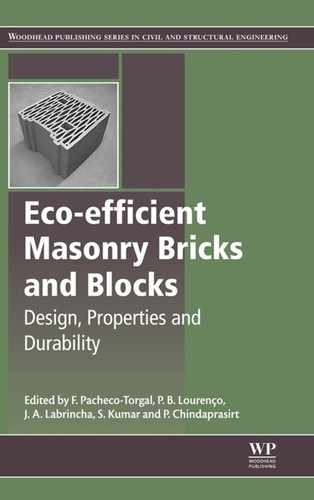Book Description
Masonry walls constitute the interface between the building’s interior and the outdoor environment. Masonry walls are traditionally composed of fired-clay bricks (solid or perforated) or blocks (concrete or earth-based), but in the past (and even in the present) they were often associated as needing an extra special thermal and acoustical insulation layer. However, over more recent years investigations on thermal and acoustical features has led to the development of new improved bricks and blocks that no longer need these insulation layers. Traditional masonry units (fired-clay bricks, concrete or earth-based blocks) that don’t offer improved performance in terms of thermal and acoustical insulation are a symbol of a low-technology past, that are far removed from the demands of sustainable construction.
This book provides an up-to-date state-of-the-art review on the eco-efficiency of masonry units, particular emphasis is placed on the design, properties, performance, durability and LCA of these materials. Since masonry units are also an excellent way to reuse bulk industrial waste the book will be important in the context of the Revised Waste Framework Directive 2008/98/EC which states that the minimum reuse and recycling targets for construction and demolition waste (CDW) should be at least 70% by 2020. On the 9th of March 2011 the European Union approved the Regulation (EU) 305/2011, known as the Construction Products Regulation (CPR) and it will be enforced after the 1st of July 2013. The future commercialization of construction materials in Europe makes their environmental assessment mandatory meaning that more information related to the environmental performance of building materials is much needed.
- Provides an authoritative guide to the eco-efficiency of masonry units
- Examines the reuse of waste materials
- Covers a range of materials including, clay, cement, earth and pumice
Table of Contents
- Cover image
- Title page
- Table of Contents
- Related titles
- Copyright
- List of contributors
- Woodhead Publishing Series in Civil and Structural Engineering
- Foreword
- 1. Introduction to eco-efficient masonry bricks and blocks
- Part One. Design, properties and thermal performance of large and highly perforated fired-clay masonry bricks
- 2. The design and mechanical performance of high-performance perforated fired masonry bricks
- 3. Influence of large and highly perforated fired-clay bricks in the improvement of the equivalent thermal transmittance of single-leaf masonry walls
- 4. Traditional fired-clay bricks versus large and highly perforated fired-clay bricks masonry: influence on buildings thermal performance
- Part Two. The design, properties and durability of fired-clay masonry bricks containing industrial wastes
- 5. The properties and durability of clay fly ash-based fired masonry bricks
- 6. Types of waste, properties, and durability of pore-forming waste-based fired masonry bricks
- 7. Types of waste, properties and durability of toxic waste-based fired masonry bricks
- 7.1. Introduction
- 7.2. Industrial waste classification used in fired masonry bricks
- 7.3. Comparison between clay minerals and the alternative raw materials
- 7.4. Firing conditions used in the manufacture of waste-based fired bricks
- 7.5. Characteristics of waste-based fired bricks
- 7.6. Current framework
- 7.7. Conclusions and future trends
- Part Three. The design, properties and durability of Portland cement concrete masonry blocks
- 8. The properties and durability of high-pozzolanic industrial by-products content concrete masonry blocks
- 9. The properties and durability of autoclaved aerated concrete masonry blocks
- 9.1. Introduction
- 9.2. Types of lightweight concrete
- 9.3. Autoclaved aerated concrete (AAC) history and utilization as masonry blocks
- 9.4. Manufacturing and mechanism of autoclaved aerated concrete
- 9.5. Physical properties of autoclaved aerated concrete
- 9.6. Mechanical properties of autoclaved aerated concrete
- 9.7. Microstructure of autoclaved aerated concrete
- 9.8. Characterizations of autoclaved aerated concrete
- 9.9. Thermal conductivity of bottom ash cement autoclaved aerated concrete
- 9.10. Durability of autoclaved aerated concrete
- 9.11. Conclusions and future trends
- 9.12. Sources of further information and advice
- 10. The design, properties, and performance of concrete masonry blocks with phase change materials
- 11. The design, properties and performance of shape optimized masonry blocks
- Part Four. The design, properties and durability of geopolymeric masonry blocks
- 12. The properties and durability of fly ash-based geopolymeric masonry bricks
- 13. The properties and durability of mine tailings-based geopolymeric masonry blocks
- 13.1. Introduction
- 13.2. Mine tailings (MT)-based geopolymer
- 13.3. Synthesis and physical and mechanical properties of MT-based geopolymer masonry blocks
- 13.4. Durability of MT-based geopolymer masonry blocks
- 13.5. Environmental performance of MT-based geopolymer masonry blocks
- 13.6. Conclusions and future trends
- 14. The properties and performance of red mud-based geopolymeric masonry blocks
- 15. Design and properties of fly ash, ground granulated blast furnace slag, silica fume and metakaolin geopolymeric based masonry blocks
- Part Five. The properties and durability of earth-based masonry blocks
- Part Six. Topology optimization and environmental performance
- 19. Topology optimization for the development of eco-efficient masonry units
- 20. Environmental performance and energy assessment of fired-clay brick masonry
- 21. Assessment of the energy and carbon embodied in straw and clay masonry blocks
- 22. Earth-block versus sandcrete-block houses: embodied energy and CO2 assessment
- 22.1. Background
- 22.2. Embodied energy and CO2: an overview
- 22.3. Embodied energy and CO2-related studies
- 22.4. Assessment methodology
- 22.5. The description of the object of the assessment and system boundary
- 22.6. The methods of assessment
- 22.7. Data collection methods
- 22.8. Inventory sources
- 22.9. Mathematical models underpinning the process analysis approach
- 22.10. Calculations and the use of tools
- 22.11. Data aggregation
- 22.12. Assessments of embodied energy and CO2: case studies' applications
- 22.13. Validation of results using building information modeling (BIM) software
- 22.14. Discussion and analysis
- 22.15. Conclusions
- Index
